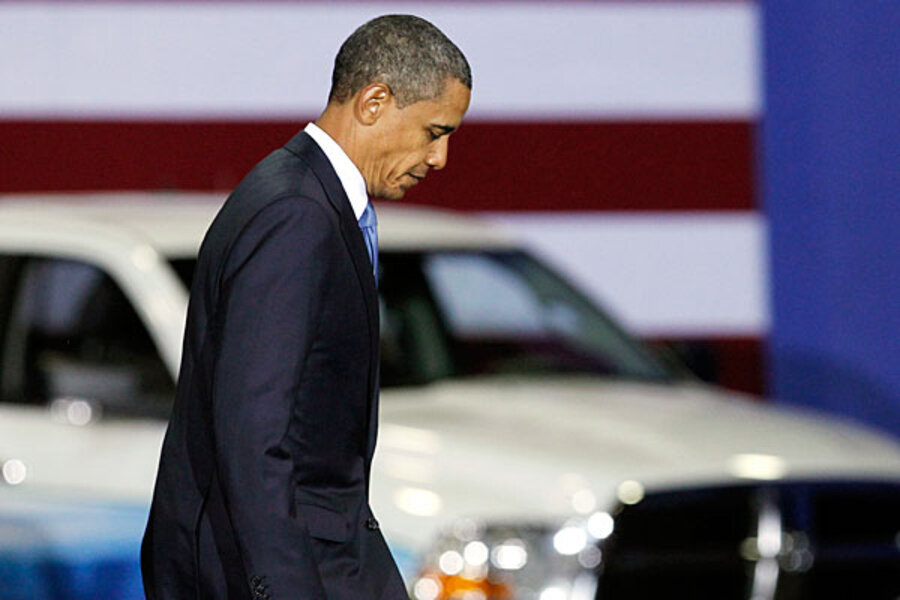Fuel-efficient US cars? Obama sets target of 54.5 mpg by 2025.
US vehicle fleets will need to average 54.5 miles per gallon beginning in 2025, about double the level today and one automakers had for years declared was impossible, according to new fuel-efficiency standards set Tuesday by the Obama administration.
The new standards – endorsed by automakers as facilitating long-term planning and lauded by environmentalists as leading toward a cleaner energy future – were nevertheless deplored by some Republicans in Congress as burdensome.
As part of its program to improve fuel economy and reduce greenhouse gas emissions, the administration previously set a goal of 35.5 miles per gallon by 2016.
Tuesday’s move vaults the energy-saving engine technology bar yet again for automakers – and for individual consumers, who are projected to save thousands of dollars at the gas pump on their way to cutting US oil consumption by about 700 million barrels per year.
“These fuel standards represent the single most important step we’ve ever taken to reduce our dependence on foreign oil,” President Obama said in a statement. “This historic agreement builds on the progress we’ve already made to save families money at the pump and cut our oil consumption."
By the middle of the next decade, US vehicles will on average achieve almost double the mileage they do today, Mr. Obama noted. Besides strengthening US energy security, the move was "good for middle-class families" and would boost the economy, he said.
That statement was backed up by automakers. After decades of resisting such steps, US-based automakers – whose sales are strong at present – seemed in lock step in saying the new standards would help them make better investments by creating greater regulatory certainty rather than having to meet clean-air rules on a state-by-state basis.
"The Auto Alliance has called for a single, national program because conflicting requirements from several regulatory bodies raise costs, ultimately taking money out of consumers' pockets and hurting sales," the group of 13 major automakers – including Ford, GM, Chrysler, BMW, Honda, Hyundai, Jaguar/Land Rover, Kia, Mazda, Mitsubishi, Nissan, Toyota, and Volvo – said in a statement. "We all want to get more fuel-efficient autos on our roads, and a single, national program with a strong midterm review helps us get closer to that shared goal."
Transportation Secretary Ray LaHood and Environmental Protection Agency Administrator Lisa Jackson, whose agencies tightly coordinated to arrive at achievable pollution and fuel-reduction numbers that the automakers could live with, announced the mileage standards at a press conference.
“Simply put, this groundbreaking program will result in vehicles that use less gas, travel farther, and provide more efficiency for consumers than ever before – all while protecting the air we breathe and giving automakers the regulatory certainty to build the cars of the future here in America,” Secretary LaHood said at a Washington press conference.
Breaking the numbers down, Lahood projected consumers would save an average of $8,000 over the life of their vehicles by 2025. The net savings, he said, would be comparable to lowering the price of gasoline by approximately $1 per gallon. Overall, Obama-era fuel-savings programs will by 2025 reduce US reliance on foreign oil by about 2 million barrels a day – nearly half of the oil imported from Organization of Petroleum Exporting Countries each day.
Environmentalists hailed the move for setting the nation on a path to help reduce greenhouse gas emission from vehicle tail pipes. Between 2011 and 2025 some 6 billion tons in emissions would be prevented – more than all the carbon dioxide emitted by the US in 2010.
“As a onetime General Motors mechanic, I’m proud to see Americans already proving we have what it takes to lead in a prosperous clean energy future," Larry Schweiger, president of the National Wildlife Federation, said in a statement. "Taken together, new fuel economy standards for cars and trucks are the biggest step America has ever taken to cut carbon pollution and reduce our oil dependence, critical for wildlife which faces both the global threat of climate change and the direct impacts of oil spills and pollution."
Not everyone was happy. Republicans in the House of Representatives decried what they depicted as government dumping more burdensome regulations on a struggling industry. It would even produce a physical threat to consumers, who would be forced to drive smaller cars that would not be as safe as larger vehicles today, some said.
“The rule finalized today by the Obama administration will hurt American consumers by forcing them to drive more expensive and less safe automobiles," said Rep. Darrell Issa (R) of Calif. "The administration drafted these standards in secret, strong-arming automakers and short-circuiting the deliberative regulatory process to achieve a purely political result, abandoning sound science and objectivity to appease its political allies in the extreme environmentalist lobby.”
But officials with Ceres, a Boston-based network of green investor groups targeting climate change, took exception to that narrative, saying the US auto industry is embracing the rules mindful of its own self-interest.
Over the long run, US automakers can expect $2.44 billion in added profits and 300,000 additional vehicle sales by 2020, according to Ceres analysis, backing up the industry's own statement. The new standard will drive industry innovation and create 484,000 new US jobs, Ceres projects.
"Automakers know that offering buyers a wide range of cars and trucks that go farther on a gallon of gas is good for sales and profits in the United States and around the world," said Mindy Lubber, Ceres president, in a statement. "When the rubber meets the road on the 54.5-mpg standard, they better be ready – or they’ll be left behind.”






